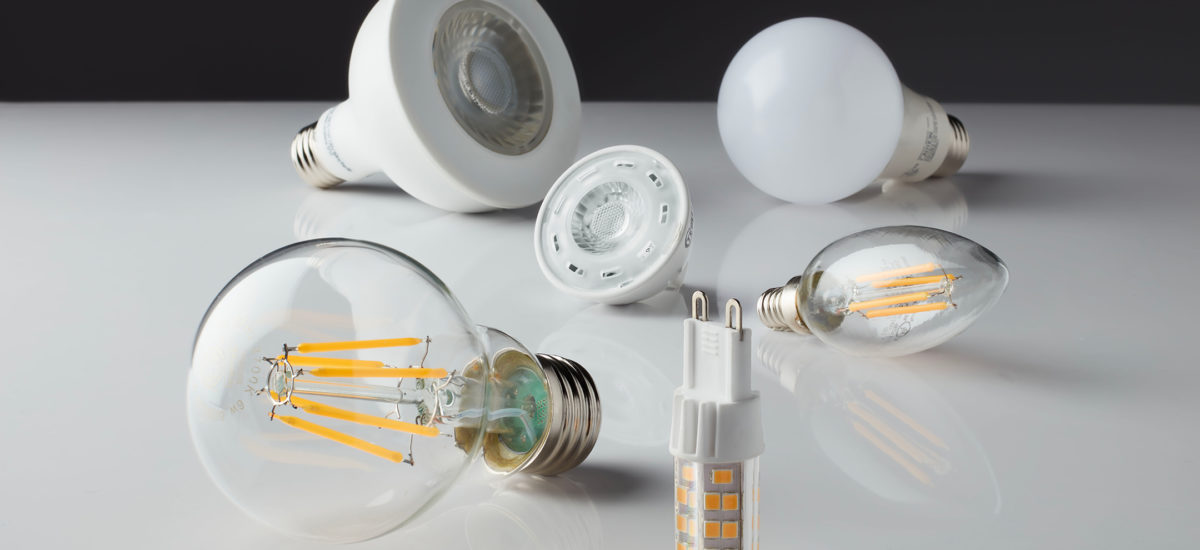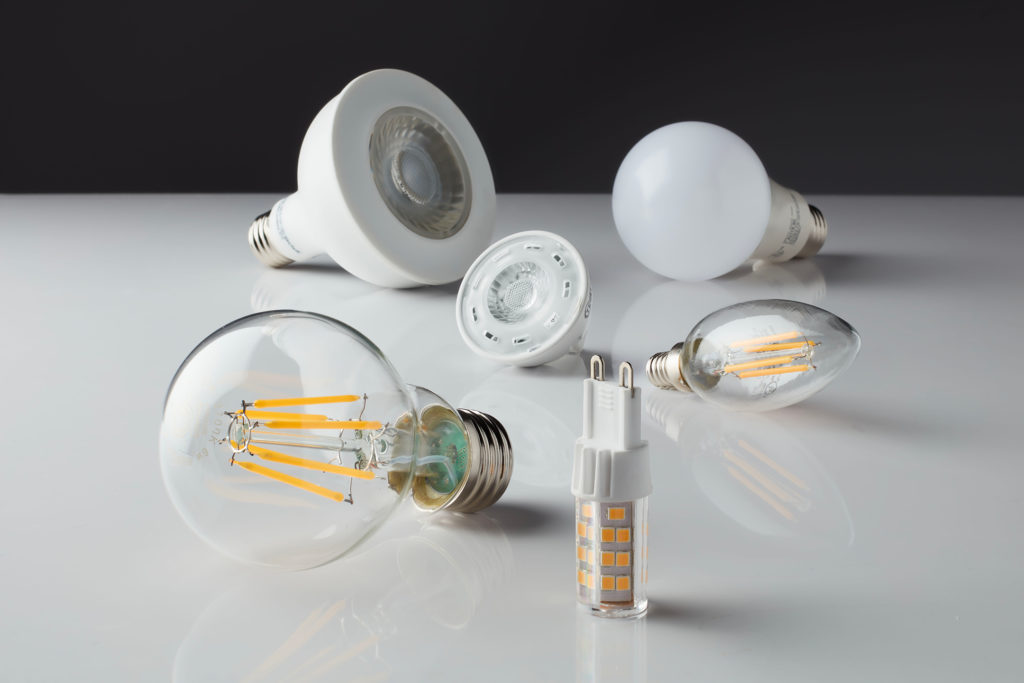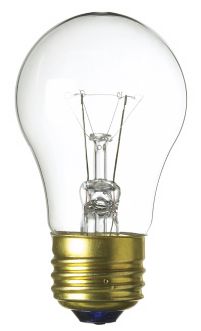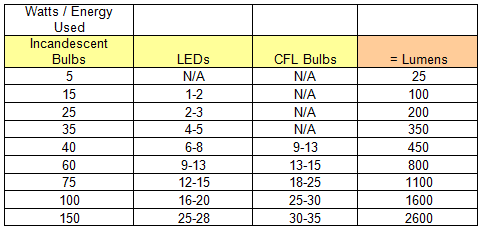The Most Common Light Bulb Questions: A Light Bulb Guide and Bulb FAQ Cheat Sheet from Lamps Plus

Don’t know what light bulb type to purchase? Have questions about wattage, lifespan, lumens, or why your bulb just can’t stop flickering?
Here’s a list of the most frequently asked questions we’ve received about light bulbs and light bulb types.

Light Bulb Types
What are the different types of light bulbs?
The most common types of light bulbs are incandescent bulbs, halogen bulbs, CFL bulbs, and LED bulbs. For each of these types, the bulb light is produced by a different process.
Light bulbs can also be distinguished by shape and base design. These differences do matter, as certain types of bulbs are recommended for certain types of fixtures.
You can check out our light bulb identifier and finder guide for what light bulb type to buy for a particular fixture.
What are the different light bulbs based on how they work?
- Incandescent – passes an electric current through a metal filament to produce heat
- Halogen – recycles halogen gas and tungsten within a quartz envelope
- CFL (compact fluorescent light) – passes an electric current through a gaseous tube
- LED (light emitting diode) – passes an electric current through a semi-conducting material, currently the most energy efficient type of bulb
What are the different light bulb shapes?
The most common light bulb shapes are:
- Standard Household – denoted with an A
- Candle – denoted with a C
- Reflector – denoted with an R
- Mini Reflector – denoted with MR
- Parabolic Aluminized Reflector – denoted with PAR
- Globe – denoted with G
- Tubular – denoted with a T
The light bulb shape code will be listed on the packaging. The shape code consists of a letter that indicated the physical shape, followed by a number that indicates the size (measured in eighths of a diameter). For example, an “A19 bulb” means that that the bulb comes in a standard household shape and is 19/8 inches in size. A19 bulbs are the most common light bulb shape, so this is what you’ll see the most.
What are the different light bulb bases?
The most common light bulb base types are:
- Standard-medium – a regular sized screw-in base, usually denoted with an E26 or E27
- Candelabra – a smaller screw-in base, denoted most often with an E12
- Bi-pin – a pin-in base with two points of contact, often denoted by a G4 or GU24
- GU10 – a twist-and-lock base
The letter indicates the shape of the base, while the number indicates the size. Always check your lighting fixture before purchasing bulbs. After all, you couldn’t screw in an E26 bulb into a candelabra socket size – it just isn’t possible!
These are the basics on light bulb bases. Sizes and shapes do matter – so be mindful before purchasing a new bulb. If you need more about light bulb bases explained, be sure to ask a store associate before purchasing a bulb.
What are the long light bulbs called?
Long bulbs can either be short tubular or tube light bulbs or fluorescent tube bulbs. Tube light bulbs are shorter and are used to give a decorative look to fixtures and lamps. Fluorescent tubes are longer usually and are seen ion overhead lights and ceiling panel lights.

How Light Bulbs Work
What is wattage?
Wattage is a unit of measurement for electric power. Whenever you buy a light bulb, the wattage will be listed on the packaging.
The higher the wattage, the more energy is consumed. Ideally, you should go for a light bulb with a lower wattage, such as LED bulbs, which use less power and are more energy-efficient.
What is color temperature?
Color temperature refers to the color of the light that is emitted.
Color temperature is measured by a unit called Kelvins (K). The lower the Kelvin count, the warmer and yellower the light is. The higher the Kelvin counter, the cooler and whiter the light is.
For a more in-depth explanation, check out our color temperature guide.
What are lumens?
Lumen is a unit of measurement for luminous flux – the total amount of visible light that is emitted.
The higher the lumen count, the more light that is emitted. So if you want a bulb that gives off a lot of light, get one with a higher lumen count. Conversely, if you want a bulb that gives off a dimmer light, get one with a lower lumen count.
How do I convert lumens to watts?
Follow this chart to find out how to convert lumens to watts.

As you can see, lumen-to-watts conversion depends on what type of lighting it is.
For example, 800 lumens is equivalent to 60 watts for incandescent bulbs, 13 to 15 watts for CFL bulbs, and 9 to 13 watts for LED bulbs.
How do I determine light bulb brightness?
The brightness of a light bulb is determined by the lumens.
To figure out the bulb brightness, look at the listed lumen count instead the wattage or color temperature. Wattage refers to how much power the bulb uses, while color temperature indicates the warmth or coolness of the light color. Lumens are a measure of the amount of light that is produced. The higher the lumen count, the more illumination is produced and the brighter the light seems as a result.
Light Bulb Life
How long do light bulbs last?
Light bulb lifespan depends on the type of bulb.
For example, incandescent bulbs average 1,000 hours, while LED light bulbs last ten times longer at 10,000 hours. But every bulb is different, so check out the product details to find out the exact lifespan of each bulb.
How long do incandescent bulbs last?
Incandescent bulbs last 1000 hours on average. The exception to this is halogen bulbs, which are a specialized type of incandescent lights. They have a different average lifespan.
How long do halogen bulbs last?
Halogen bulbs last 2000 hours on average. This makes halogen bulbs twice as efficient as standard incandescent bulbs.
How long do CFL bulbs last?
Compact fluorescent light bulbs (also known as CFL bulbs) last 10,000 hours on average. This makes CFL bulbs as efficient as standard incandescent bulbs.
How long do LED bulbs last?
LED bulbs last 25,000 hours on average. This makes LEDs ten times more efficient than standard incandescent bulbs and more than twice as efficient as CFL lights. LED bulb light offers the most power-saving type of lighting on the market.

Light Bulb Safety
What is the highest wattage bulb I can use for a light fixture?
The most common maximum wattage is 60 watts, but it depends on the fixture. We highly recommend that you check the maximum recommended wattage before installing a light bulb. The recommended wattage is usually listed on a label or included in the instructions.
Can I put in a higher watt light bulb than what is recommended?
No, you should never go over the recommended maximum wattage for a lighting fixture.
That recommendation is there for a reason. If you install a light bulb with a higher wattage than is recommended, you risk damaging or overheating your light fixture – possibly even starting a fire!
How do I handle light bulbs with mercury?
Light bulbs with mercury (usually CFL bulbs) are completely safe to use. The amount of mercury is minimal, and no mercury is actually released when the bulb is in use.
That being said, a small amount of mercury can be released when the bulb is broken. To avoid breakage, handle with care. If the light bulb does break, do not just vacuum it up, as vacuuming could spread the mercury vapors. Air out the room first, and then carefully collect the broken fragments using stiff paper or cardboard, then sticky tape, and put them into a sealed bag before throwing away.
The EPA recommends recycling mercury light bulbs after they burn out, either at a local waste collection agency, local retailer that supports recycling, or even through a mail-back service.
Can I put a dimmable bulb in a non dimmable socket?
Yes, you can put a dimmable light bulb into a non-dimmable socket. It will work the same as any other light bulb.
Can I put a non dimmable bulb into a dimmable socket?
Yes, you can put a non-dimmable bulb into a dimmable socket.
However, if you actually try dimming the light, you’ll probably get flickering lighting or other problems. Don’t expect smoothly dimming lights if you buy a non-dimmable bulb!

Choosing the Best Light Bulbs
What are the most eco friendly light bulbs?
The most eco friendly light bulbs are LED light bulbs, which an energy efficient design. Not only do LED lights consume less energy than other bulb types, they last longer (about ten times more than regular incandescent lights), which means less materials used in manufacturing long-term.
While there may be improvements to lighting technology in the future, LED lights are currently the most eco friendly light bulbs the market has to offer.
What type of bulb should I get to conserve lighting energy?
You should get LED light bulbs to conserve lighting energy.
As stated above, LED lights are currently the power-saving design on the market. LED lighting efficiency is about ten times more effective that the efficiency of incandescent light bulbs.
What are the best natural lighting bulbs?
To imitate natural lighting, try bulbs with a warm lighting source. A bulb with a lower color temperature from 2700K to 2900K is best. Bulbs with a higher color temperature emit a cool white light, which seems more artificial.
Natural lighting bulbs are best used with kitchen lights, bathroom light fixtures, or a vanity mirror with lights.
What is the best dusk to dawn bulb?
For dusk-to-dawn purposes, we recommend using LED bulbs, as they are the most durable and longest-lasting type of bulb.
What is the best RGB light bulb?
The best RGB (red-blue-green) light bulbs, also known as color changing bulbs, are energy-efficient LED designs. For further convenience, get an app controlled bulb, which allows you to change the color from your smartphone or other device.
Check out our selection of colored light bulbs to find the best RGB light bulb design for you.
Other Questions
Why do I have flickering light bulbs?
A flickering light bulb can indicate many things. It usually means that the bulb is nearing the end of its lifespan and needs to be replaced. However, flicker lights could also indicate that the bulb is not screwed on properly, or that there are loose electrical connections or voltage problems in your house. If you have already replaced a flickering bulb but the problem persists, then you should investigate for wiring and voltage issues.
There are some decorative bulbs that are designed to have a special flicker effect. However, such flicker flame light bulb designs are obviously packaged and marketed as such. Flicker lights are a great choice for holidays like Halloween or Christmas.
What voltage bulb should I use?
The most common voltage for electric light bulbs is 120 volts (120V). This is the default voltage for most lighting fixtures.
However, some lighting fixtures are low voltage. Low voltage lighting is more energy-efficient, but it requires low voltage bulbs to work. In that case, you should buy a bulb labelled 12 volts (12V). Many landscape lights and outdoor lighting fixtures require low voltage bulbs.
For truly great energy efficiency, try using low-voltage LED bulbs. Voltage that’s low combined with LED technology makes for a greatly effective power-saving design.
What type of bulb should I use for electric lights?
You can use any type of bulb for electric lights – LED light bulbs, incandescent light bulbs, fluorescent light bulbs, and so on. All light bulbs are designed to be powered by electricity.
What are the different halogen lamp types?
The most common types of halogen lamps are tubular bulbs, mini reflectors, and PAR reflectors.
Short tubular or candle halogen bulbs are halogen lamp types that are best used as pendant or chandelier light bulbs, or in torchiere lights, desk and table lamps, and other portable lighting types.
Mini-reflector halogen lamps are usually used in accent and spot lighting in track and landscape designs.
A PAR halogen lamp has a wide reflective surface and is usually used in normal track and recessed lighting.
More Questions?
Call 800-782-1967 to speak with one of our friendly, professional Lighting & Home Decor Consultants or visit a Lamps Plus lighting store location near you. Whether via phone or in person, we’re happy to assist you in choosing the right light bulb, whether you want to replace an old light bulb or fit out a new lighting fixture. Our consultants can help you pick out an LED ceiling fan, size a pendant light, enhance your kitchen lighting, and more.
More Light Bulb Ideas and Advice
Lumens to Watts: the Key to Buying Replacement Light Bulbs
Light Bulb Identifier and Finder Guide
How an Incandescent Bulb Works
